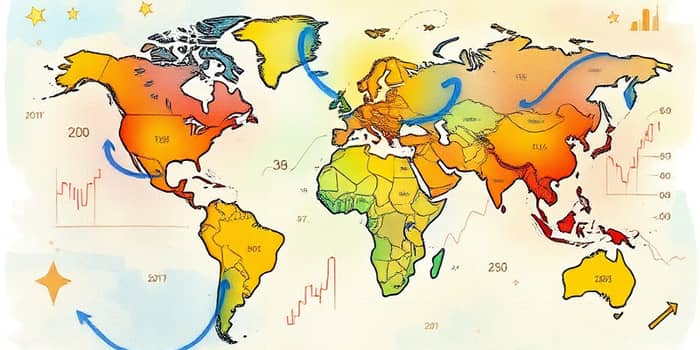In an increasingly connected world, allocating capital beyond domestic borders has become both an art and a science. International investment plans provide individuals and institutions with avenues to tap into new markets, seek higher returns, and safeguard value against local downturns.
While the allure of global opportunities is strong, success requires a clear roadmap. By understanding core concepts, weighing risks, and following a structured approach, investors can harness long-term growth potential in emerging markets and mature economies alike.
Defining International Investment
At its essence, international investment means deploying capital outside one’s home country. It serves two primary goals: enhancing diversification and capturing returns unavailable domestically. There are three major categories to consider:
- Foreign Direct Investment (FDI): Establishing lasting ownership and managerial influence—through mergers, joint ventures, or new subsidiaries.
- Foreign Portfolio Investment (FPI): Purchasing stocks, bonds, or other securities on foreign exchanges, without direct control.
- Indirect Investments: Allocations made by institutions into international funds or vehicles that hold foreign assets.
Vehicles and Diversification Strategies
Choosing the right investment vehicle is pivotal. Each offers varying degrees of liquidity, risk, and exposure:
- Mutual Funds: Actively or passively managed, these funds can be global, regional, or sector-specific.
- ETFs (Exchange-Traded Funds): Trade like stocks but track international or country-specific indexes.
- ADRs (American Depositary Receipts): Enable U.S. investors to hold shares in foreign companies without navigating local exchanges.
- Direct Purchase: Buying foreign equities or debt directly through international brokers.
By blending allocations across developed markets (e.g., Europe, Japan) and emerging economies (e.g., India, Brazil, China), investors achieve strategic global diversification and risk management.
Strategic Rationale for Going Global
Why venture beyond national boundaries when domestic opportunities abound? The answer lies in three interrelated drivers:
1. Diversification: Spreading capital across economies reduces vulnerability to any single market’s downturn.
2. Growth Potential: Emerging markets often outpace developed peers, driven by demographic shifts and rapid industrialization.
3. Currency Exposure: Fluctuations can enhance returns when foreign currencies strengthen against the investor’s home currency.
When combined effectively, these factors foster a more resilient investment portfolio over time.
Risks and Considerations
International investing is not without pitfalls. Carefully weighing these risks is essential to crafting a robust plan:
Currency Risk: Exchange rate swings can erode gains or amplify losses unexpectedly.
Political and Economic Instability: Regulatory changes, policy shifts, and social unrest may impact returns.
Taxation and Costs: Withholding taxes, legal fees, and higher transaction expenses can reduce net performance.
Liquidity Constraints: Some foreign securities trade less frequently, making entry and exit more challenging.
Practical Steps to Launch Your Plan
- Define Objectives: Clarify your risk tolerance, return expectations, and time horizon.
- Select Vehicles: Choose from mutual funds, ETFs, ADRs, or direct holdings based on costs and access.
- Research Thoroughly: Evaluate regions, sectors, and issuers, paying attention to market maturity.
- Manage Risks: Employ diversification, hedging strategies, and stop-loss mechanisms.
- Monitor and Adjust: Track global developments and portfolio performance; rebalance as needed.
Building a Robust Business Plan
Crafting an international investment plan resembles writing a comprehensive business proposal. A well-structured document typically includes:
By documenting each component, investors establish a clear roadmap for disciplined decision-making and accountability.
Impact on Sustainable Development
Beyond financial returns, international capital flows can drive positive change. Aligning allocations with the United Nations’ Sustainable Development Goals amplifies social impact:
- Supporting infrastructure projects in developing nations
- Encouraging environmental, social, and governance (ESG) practices
- Channeling FDI into small island and least developed states under SDG 10.B
Such commitments create a virtuous cycle of growth, poverty reduction, and environmental stewardship, illustrating how investment can empower communities globally.
Conclusion
Designing and executing an international investment plan demands diligence, creativity, and strategic foresight. By mastering definitions, choosing suitable vehicles, understanding risks, and formalizing a business-style blueprint, investors can position themselves to capture global opportunities.
Embrace the challenge of venturing beyond borders, and let your capital become a catalyst for both personal prosperity and sustainable progress around the world.
References
- https://www.investor.gov/introduction-investing/investing-basics/investment-products/international-investing
- https://www.investopedia.com/terms/f/foreign-investment.asp
- https://investor.vanguard.com/investor-resources-education/understanding-investment-types/why-invest-internationally
- https://international.schwab.com/investment-products
- https://www.sec.gov/reportspubs/investor-publications/investorpubsininvest
- https://www.investopedia.com/terms/b/business-plan.asp
- https://www.blackrock.com/americas-offshore/en/strategies/international-investing
- https://www.un.org/sustainabledevelopment/inequality/










